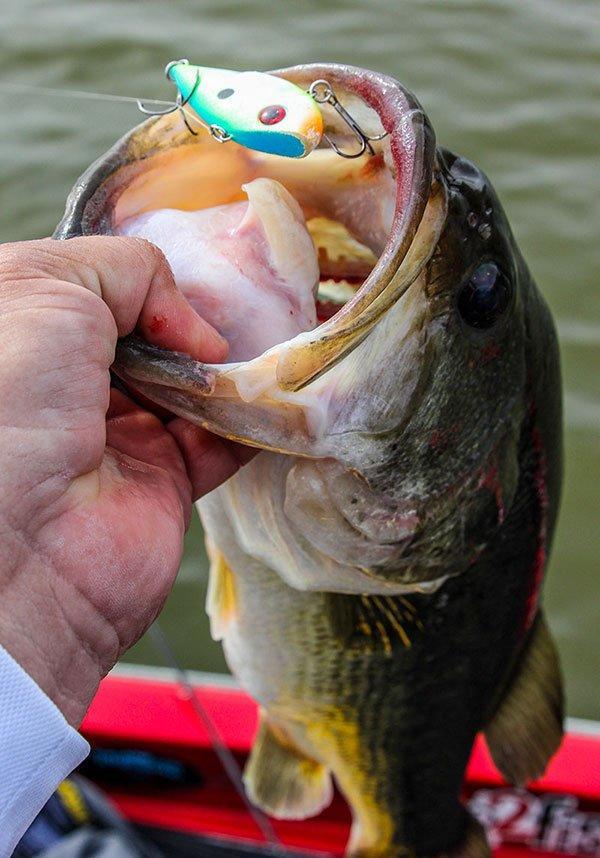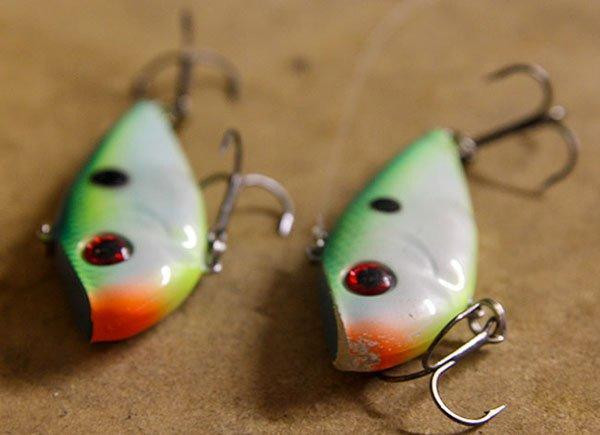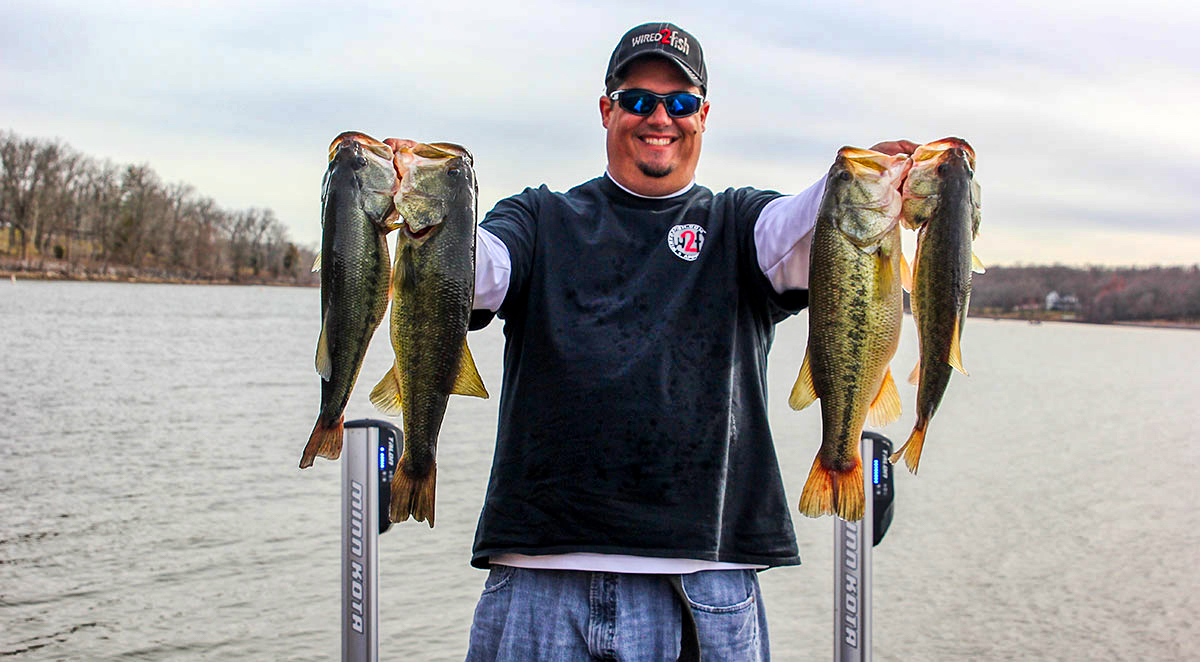When many of us think of fishing lipless crankbaits, we tend to envision ourselves ripping them through dense vegetation on heavy braided line. While that’s definitely an exciting and effective way to catch big bass, lipless crankbaits aren’t just effective in grass-filled fisheries””they’re also an outstanding choice when targeting transitioning spring bass.
Prespawn basics
When bass get into their full-on prespawn mode they’re relatively easy to pattern, but the awkward transition phase leading up to that point can be downright frustrating. When you finally locate a good group of fish, it’s tough to make them bite. Lipless crankbaits are an effective remedy to these stubborn bass.
We’ve been having some productive days on the water recently by targeting secondary points, stump flats adjacent to deep water and “lead-in” banks””stretches of bank that bass use to migrate toward spawning flats. There’s a common misconception that lipless crankbaits are only suitable for use in intermediate water depths in areas void of snag-inducing cover, but we’ve been catching some giant bass in only inches of water.
To get the most out of this technique, it’s important to parallel the bank in order to keep your bait in the strike zone for as long as possible. Following a long cast, keep your rod tip straight up in the air to avoid hang-ups and retrieve your lipless crank so it barely ticks the bottom. This ticking sound is essential and can make the difference between a slow and killer day on the water.
As your bait works towards deeper water, slowly drop your rod tip and slow your retrieve to keep contact with the bottom. If you feel your rod start to load, don’t mistake it for a snag. Even the biggest won’t always eat it aggressively, so make sure to set the hook at the slightest inkling of a bite.
Prespawn cold fronts
We’ve also found lipless crankbaits to be very effective during prespawn cold fronts. With prespawn bass being especially susceptible to sudden weather changes, it can be a nightmare when a cold front pushes them away from their predictable prespawn hideouts. Fortunately, a lipless crankbait can prove to be the Great Equalizer in these situations.
Whenever a cold front hits during the prespawn, make sure to focus on break lines between shallow and deep water. If you were previously catching your bass on a flat, target areas where it transitions into deeper water. When you find the depth transition, make long casts parallel to the break line and try “worming” your lipless crank.
Just as the name implies, “worming” your lipless crankbaits involves fishing it like a Texas rig to mimic a dying shad. During a cold front, prespawners are less apt to aggressively chase down a meal, making this overlooked technique deadly when faced with stubborn bass. Drag it along the bottom by lifting your rod tip slowly and dropping your rod when retrieving slack line. When it feels “mushy”, set the hook and hold on.
Although lipless crankbaits don’t have a bill to deflect the bait off of obstacles, don’t shy away from bass-holding cover such as stumps or chunk rock. These baits swim through the water nose-down, protecting the hooks from the majority of hang-ups. Some of our “tried and true” lipless crankbaits have absolutely no paint or clear coat on their noses from repeatedly ramming them into cover.
Post-spawn
When the water temperature is in the 65 to 72-degree range as the bass begin transitioning toward their deep, summertime hangouts, you can expect a solid lipless crank bite.
Spawning rituals wear out big bass and by the time it’s all over, they’re hungry and ready to devour whatever crosses their path. We’ve had great results yo-yoing lipless crankbaits to take advantage of the aggressive feeding behavior. The areas we target are almost identical to our prespawn targets, except in reverse order.
As the bass finish up their business in the shallows, they’ll start working their way toward deeper water via secondary points, creek channels, primary points and finally river channels. It’s not at all uncommon to encounter suspended bass in the post-spawn, making the yo-yo technique extremely effective.
To yo-yo your lipless crankbait, allow it to fall to the bottom and make long, upward sweeps with your rod. In order to maximize your hookup ratio, make sure to let the bait fall with controlled slack””too much slack line will hinder your ability to detect bites on the fall and a tight line won’t allow the bait to shimmy on the fall.
Be sure to keep a close watch on your line as the bait falls””we get a lot of bites with this technique while it’s falling. If you notice any sort of tick or jump in your line, reel in your slack and set the hook immediately.
Equipment considerations
While stouter rods are desirable when ripping big lipless crankbaits through grass, we’ve found medium-action rods to be most effective when targeting transitioning spring bass. The softer, more responsive tip of a medium-action rod gives the fish more time to eat the bait, drastically decreasing the chances of accidentally ripping it from their mouths.
Every angler has different preferences, but when it comes to line selection, we generally opt for 12 or 15-pound test. Whenever we’re “worming” or yo-yoing a lipless crankbait, we prefer fluorocarbon due to its low-stretch qualities. With these techniques, you want to feel every movement that your bait is making in order to detect the subtle bites. In situations that the bass prefer a simple chunk and wind presentation, we like monofilament to discourage premature hooksets.
Because “worming” and yo-yoing require more slack in your line, we recommend using a 7.1:1 gear ratio reel. If a bass knocks slack into your line or eats the bait on the fall, you need the ability to quickly eat up your slack for an effective hookset. When ticking the bottom, you can generally get away with more generic crankbait gear ratio reels, such as a 6.3:1 or a 6.4:1. As long as you can keep contact with the bottom, use whatever you’re most comfortable with.
Whenever we’re on a solid lipless crankbait bite, you’ll likely find several different baits, such as a Strike King Red Eye Shad, XCalibur Rattle Bait, Spro Aruku Shad , Rapala Rippin Rap and the classic Bill Lewis Rat-L-Trap on our front decks. To hone in on the most productive baits, we’ll generally switch baits after approximately 50 casts until the bass “tell” us what their preference is. Lipless crankbait bites change daily, so throwing different models is an extremely important key to success.
Springtime transitioning bass can be a little tricky to catch, but a lipless crankbait is a great way to make stubborn, migrating bass commit. When you’re faced with these situations this spring, try these different retrieves to catch more bass.
(Left column: Storm Rock’n Vibe, Lucky Craft DV, Spro Aruku Shad, Jackall TN70, Bill Lewis Rat-L-Trap. Right column: Sebile Flat Shad, Rapala Rippin’ Rap, Koppers LIVETARGET Crappie rattle bait, Xcalibur XR50 Rattle Bait, Strike King Red Eye Shad)















